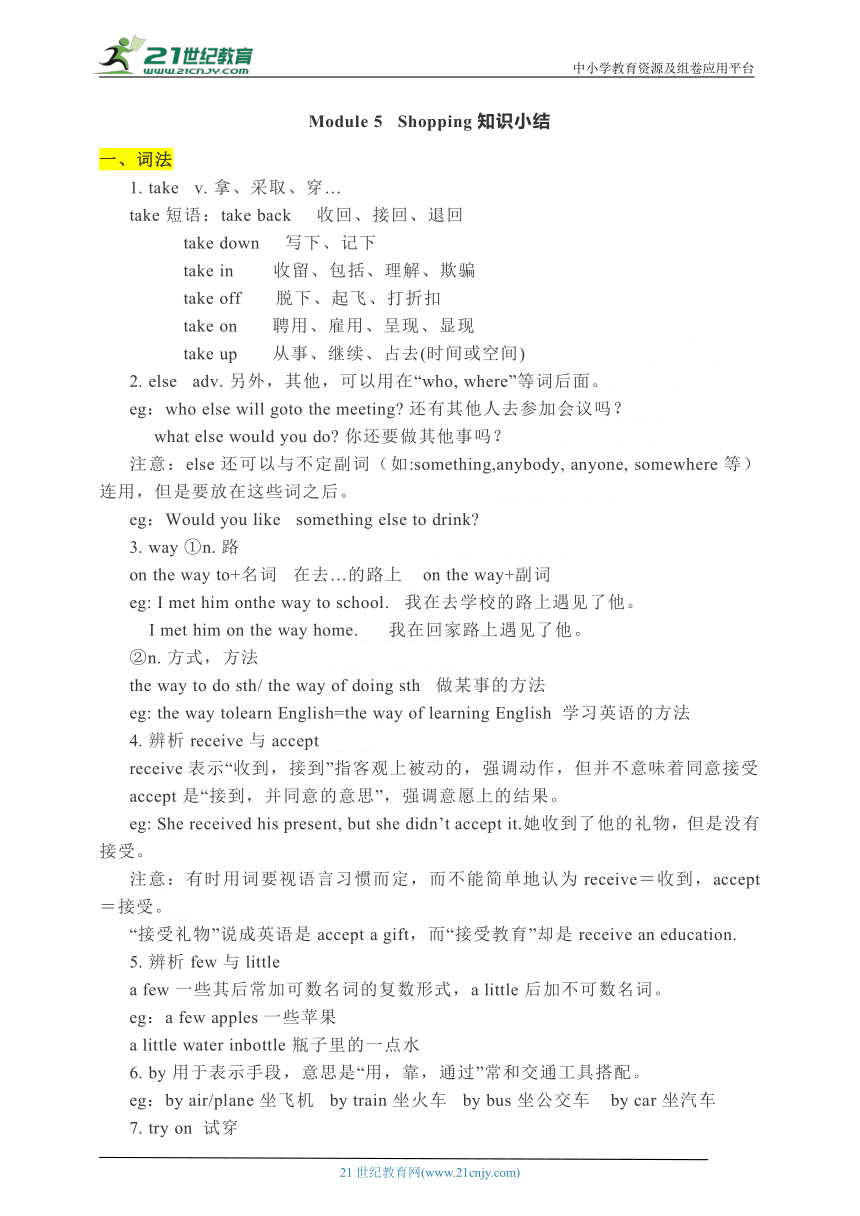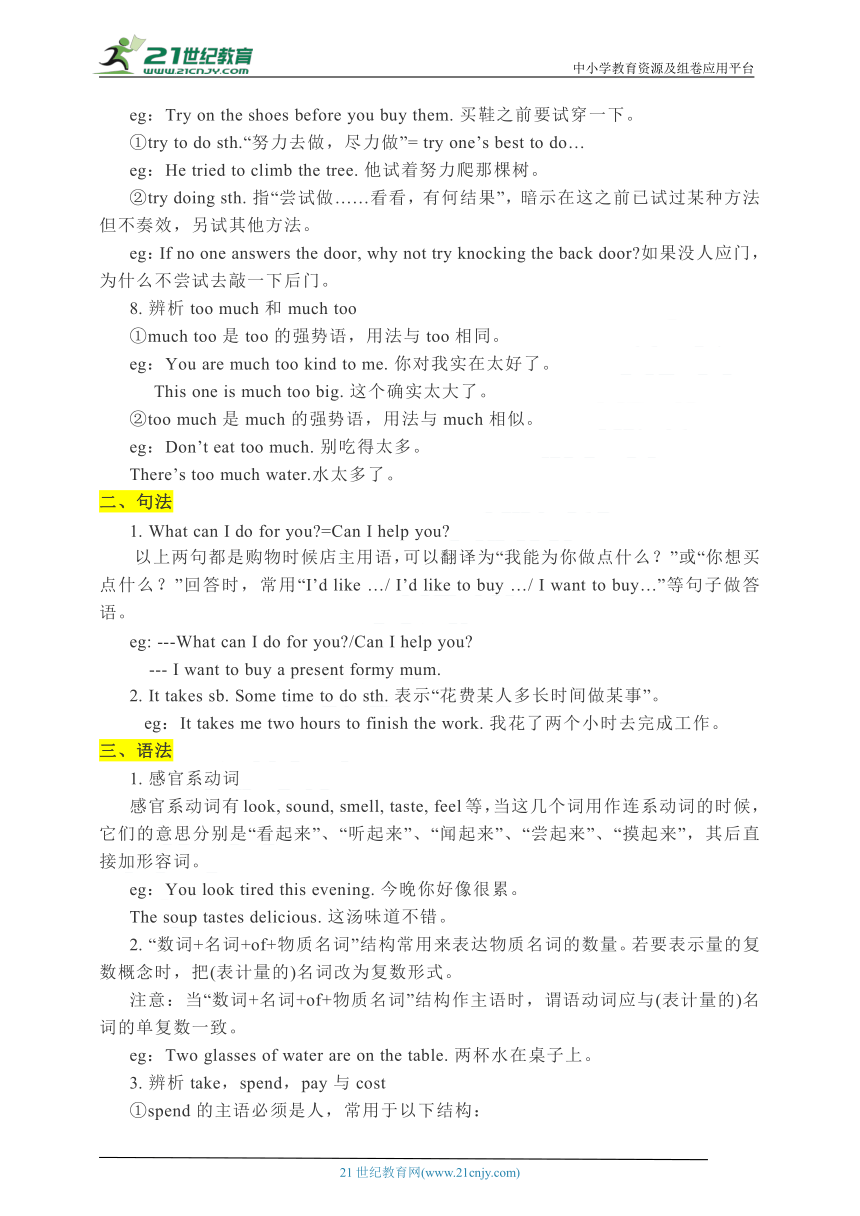Module 5 Shopping 单元重点知识小结
文档属性
| 名称 | Module 5 Shopping 单元重点知识小结 |  | |
| 格式 | doc | ||
| 文件大小 | 1.3MB | ||
| 资源类型 | 试卷 | ||
| 版本资源 | 外研版 | ||
| 科目 | 英语 | ||
| 更新时间 | 2021-04-25 14:37:36 | ||
图片预览


文档简介
中小学教育资源及组卷应用平台
Module 5? Shopping知识小结
一、词法
1. take? v.?拿、采取、穿…
take?短语:take back?????收回、接回、退回
????????? take down?????写下、记下
????????? take in????????收留、包括、理解、欺骗
????????? take off???????脱下、起飞、打折扣
????????? take on???????聘用、雇用、呈现、显现
????????? take up???????从事、继续、占去(时间或空间)
2. else? adv.?另外,其他,可以用在“who, where”等词后面。
eg:who else will goto the meeting??还有其他人去参加会议吗?
??? what else would you do??你还要做其他事吗?
注意:else?还可以与不定副词(如:something,anybody, anyone, somewhere等)连用,但是要放在这些词之后。
eg:Would you like? something else to drink?
3. way?①n.?路???
on the way to+名词???在去…的路上?? on the way+副词????????????
eg: I met him onthe way to school.???我在去学校的路上遇见了他。
?? I met him on the way home.??????我在回家路上遇见了他。?
②n.?方式,方法??
the way to do sth/ the way of doing sth???做某事的方法??????
eg: the way tolearn English=the way of learning English??学习英语的方法
4.?辨析receive与accept
receive表示“收到,接到”指客观上被动的,强调动作,但并不意味着同意接受
accept?是“接到,并同意的意思”,强调意愿上的结果。
eg: She received his present, but she didn’t accept it.她收到了他的礼物,但是没有接受。
注意:有时用词要视语言习惯而定,而不能简单地认为?receive=收到,accept=接受。
“接受礼物”说成英语是?accept a gift,而“接受教育”却是?receive an education.
5.?辨析few与little
a few?一些其后常加可数名词的复数形式,a little?后加不可数名词。
eg:a few apples?一些苹果
a little water inbottle?瓶子里的一点水
6. by?用于表示手段,意思是“用,靠,通过”常和交通工具搭配。
eg:by air/plane?坐飞机? by train?坐火车? by bus?坐公交车?? by car?坐汽车
7. try on??试穿
eg:Try on the shoes before you buy them.?买鞋之前要试穿一下。
①try to do sth.“努力去做,尽力做”= try one’s best to do…
eg:He tried to climb the tree.?他试着努力爬那棵树。
②try doing sth.?指“尝试做……看看,有何结果”,暗示在这之前已试过某种方法但不奏效,另试其他方法。
eg:If no one answers the door, why not try knocking the back door?如果没人应门,为什么不尝试去敲一下后门。
8.?辨析too much?和?much too
①much too是too的强势语,用法与too相同。
eg:You are much too kind to me.?你对我实在太好了。
??? This one is much too big.?这个确实太大了。
②too much是much的强势语,用法与much相似。
eg:Don’t eat too much.?别吃得太多。
There’s too much water.水太多了。
二、句法
1. What can I do for you?=Can I help you???
?以上两句都是购物时候店主用语,可以翻译为“我能为你做点什么?”或“你想买点什么?”回答时,常用“I’d like?…/ I’d like to buy?…/ I want to buy…”等句子做答语。
eg: ---What can I do for you?/Can I help you?
?? --- I want to buy a present formy mum.
2. It takes sb. Some time to do sth.?表示“花费某人多长时间做某事”。
? eg:It takes me two hours to finish the work.?我花了两个小时去完成工作。
三、语法
1.?感官系动词
感官系动词有look, sound, smell, taste, feel等,当这几个词用作连系动词的时候,它们的意思分别是“看起来”、“听起来”、“闻起来”、“尝起来”、“摸起来”,其后直接加形容词。
eg:You look tired this evening.?今晚你好像很累。
The soup tastes delicious.?这汤味道不错。
2.?“数词+名词+of+物质名词”结构常用来表达物质名词的数量。若要表示量的复数概念时,把(表计量的)名词改为复数形式。
注意:当“数词+名词+of+物质名词”结构作主语时,谓语动词应与(表计量的)名词的单复数一致。
eg:Two glasses of water are on the table.?两杯水在桌子上。
3.?辨析take,spend,pay与cost
①spend的主语必须是人,常用于以下结构:
(1) spend time?/money on sth.?在……上花费时间(金钱)。
eg:I spent two hours on this maths problem.?这道数学题花了我两个小时。
(2) spend time?/money (in) doing sth.?花费时间(金钱)做某事。
eg:They spent two years (in) building this bridge.??造这座桥花了他们两年时间。
(3)spend money for sth.?花钱买……。
eg:His money was spent for books.?他的钱用来买书了。
②cost的主语是物或某种活动,还可以表示“值”,常见用法如下:
(1)sth. costs (sb.)?+金钱,某物花了(某人)多少钱。
eg:A new computer costs a lot of money.?买一台新电脑要花一大笔钱。
(2) (doing) sth. costs (sb.)?+时间,某物(做某事)花了(某人)多少时间。
eg:Remembering these new words cost him a lot of time.?他花了大量时间才记住了这些单词。
注意:cost的过去式及过去分词都是cost,并且不能用于被动句。
③take后面常跟双宾语,常见用法有以下几种:
(1) It takes sb.+时间+to do sth.?做某事花了某人多少时间。
eg:It took them three years to build this road.?他们用了三年时间修完了这条路。
(2)doing sth. takes sb.?+时间,做某事花了某人多少时间。例:Repairing thiscar took him the whole afternoon.?他花了一下午修车。?
4. pay的基本用法是:
(1) pay (sb.) money for sth.?付钱(给某人)买……
eg:I have to pay them 20 pounds for this room each month.?我每个月要付20英磅的房租。
(2) pay for sth.?付……的钱。
eg:I have to pay for the book lost.?我不得不赔丢失的书款。
(3) pay for sb.?替某人付钱。
eg:Don’t worry!I'll pay for you.?别担心,我会给你付钱的。
(4) pay sb.?付钱给某人。
eg:They pay us every month.他们每月给我们报酬。
(5) pay money back?还钱。
eg:May I borrow 12 yuan from you? I'll pay it back next week.
你能借给我12块钱吗?下周还你。?
_21?????????è?????(www.21cnjy.com)_
Module 5? Shopping知识小结
一、词法
1. take? v.?拿、采取、穿…
take?短语:take back?????收回、接回、退回
????????? take down?????写下、记下
????????? take in????????收留、包括、理解、欺骗
????????? take off???????脱下、起飞、打折扣
????????? take on???????聘用、雇用、呈现、显现
????????? take up???????从事、继续、占去(时间或空间)
2. else? adv.?另外,其他,可以用在“who, where”等词后面。
eg:who else will goto the meeting??还有其他人去参加会议吗?
??? what else would you do??你还要做其他事吗?
注意:else?还可以与不定副词(如:something,anybody, anyone, somewhere等)连用,但是要放在这些词之后。
eg:Would you like? something else to drink?
3. way?①n.?路???
on the way to+名词???在去…的路上?? on the way+副词????????????
eg: I met him onthe way to school.???我在去学校的路上遇见了他。
?? I met him on the way home.??????我在回家路上遇见了他。?
②n.?方式,方法??
the way to do sth/ the way of doing sth???做某事的方法??????
eg: the way tolearn English=the way of learning English??学习英语的方法
4.?辨析receive与accept
receive表示“收到,接到”指客观上被动的,强调动作,但并不意味着同意接受
accept?是“接到,并同意的意思”,强调意愿上的结果。
eg: She received his present, but she didn’t accept it.她收到了他的礼物,但是没有接受。
注意:有时用词要视语言习惯而定,而不能简单地认为?receive=收到,accept=接受。
“接受礼物”说成英语是?accept a gift,而“接受教育”却是?receive an education.
5.?辨析few与little
a few?一些其后常加可数名词的复数形式,a little?后加不可数名词。
eg:a few apples?一些苹果
a little water inbottle?瓶子里的一点水
6. by?用于表示手段,意思是“用,靠,通过”常和交通工具搭配。
eg:by air/plane?坐飞机? by train?坐火车? by bus?坐公交车?? by car?坐汽车
7. try on??试穿
eg:Try on the shoes before you buy them.?买鞋之前要试穿一下。
①try to do sth.“努力去做,尽力做”= try one’s best to do…
eg:He tried to climb the tree.?他试着努力爬那棵树。
②try doing sth.?指“尝试做……看看,有何结果”,暗示在这之前已试过某种方法但不奏效,另试其他方法。
eg:If no one answers the door, why not try knocking the back door?如果没人应门,为什么不尝试去敲一下后门。
8.?辨析too much?和?much too
①much too是too的强势语,用法与too相同。
eg:You are much too kind to me.?你对我实在太好了。
??? This one is much too big.?这个确实太大了。
②too much是much的强势语,用法与much相似。
eg:Don’t eat too much.?别吃得太多。
There’s too much water.水太多了。
二、句法
1. What can I do for you?=Can I help you???
?以上两句都是购物时候店主用语,可以翻译为“我能为你做点什么?”或“你想买点什么?”回答时,常用“I’d like?…/ I’d like to buy?…/ I want to buy…”等句子做答语。
eg: ---What can I do for you?/Can I help you?
?? --- I want to buy a present formy mum.
2. It takes sb. Some time to do sth.?表示“花费某人多长时间做某事”。
? eg:It takes me two hours to finish the work.?我花了两个小时去完成工作。
三、语法
1.?感官系动词
感官系动词有look, sound, smell, taste, feel等,当这几个词用作连系动词的时候,它们的意思分别是“看起来”、“听起来”、“闻起来”、“尝起来”、“摸起来”,其后直接加形容词。
eg:You look tired this evening.?今晚你好像很累。
The soup tastes delicious.?这汤味道不错。
2.?“数词+名词+of+物质名词”结构常用来表达物质名词的数量。若要表示量的复数概念时,把(表计量的)名词改为复数形式。
注意:当“数词+名词+of+物质名词”结构作主语时,谓语动词应与(表计量的)名词的单复数一致。
eg:Two glasses of water are on the table.?两杯水在桌子上。
3.?辨析take,spend,pay与cost
①spend的主语必须是人,常用于以下结构:
(1) spend time?/money on sth.?在……上花费时间(金钱)。
eg:I spent two hours on this maths problem.?这道数学题花了我两个小时。
(2) spend time?/money (in) doing sth.?花费时间(金钱)做某事。
eg:They spent two years (in) building this bridge.??造这座桥花了他们两年时间。
(3)spend money for sth.?花钱买……。
eg:His money was spent for books.?他的钱用来买书了。
②cost的主语是物或某种活动,还可以表示“值”,常见用法如下:
(1)sth. costs (sb.)?+金钱,某物花了(某人)多少钱。
eg:A new computer costs a lot of money.?买一台新电脑要花一大笔钱。
(2) (doing) sth. costs (sb.)?+时间,某物(做某事)花了(某人)多少时间。
eg:Remembering these new words cost him a lot of time.?他花了大量时间才记住了这些单词。
注意:cost的过去式及过去分词都是cost,并且不能用于被动句。
③take后面常跟双宾语,常见用法有以下几种:
(1) It takes sb.+时间+to do sth.?做某事花了某人多少时间。
eg:It took them three years to build this road.?他们用了三年时间修完了这条路。
(2)doing sth. takes sb.?+时间,做某事花了某人多少时间。例:Repairing thiscar took him the whole afternoon.?他花了一下午修车。?
4. pay的基本用法是:
(1) pay (sb.) money for sth.?付钱(给某人)买……
eg:I have to pay them 20 pounds for this room each month.?我每个月要付20英磅的房租。
(2) pay for sth.?付……的钱。
eg:I have to pay for the book lost.?我不得不赔丢失的书款。
(3) pay for sb.?替某人付钱。
eg:Don’t worry!I'll pay for you.?别担心,我会给你付钱的。
(4) pay sb.?付钱给某人。
eg:They pay us every month.他们每月给我们报酬。
(5) pay money back?还钱。
eg:May I borrow 12 yuan from you? I'll pay it back next week.
你能借给我12块钱吗?下周还你。?
_21?????????è?????(www.21cnjy.com)_
同课章节目录
- Module 1 Lost and found
- Unit 1 Whose bag is this?
- Unit 2 Are they yours?
- Unit 3 Language in use
- Module 2 What can you do ?
- Unit 1 I can play the piano
- Unit 2 I can run really fast
- Unit 3 Language in use
- Module 3 Making plans
- Unit 1 What are you going to do at the weekends?
- Unit 2 We're going to cheer the players.
- Unit 3 Language in use
- Module 4 Life in the future
- Unit 1 Everyone will study at home
- Unit 2 Every family will have a small plane.
- Unit 3 Language in use
- Module 5 Shopping
- Unit 1 What can I do for you?
- Unit 2 You can buy everything on the Internet
- Unit 3 Language in use
- Module 6 Around town
- Unit 1 Could you tell me how to get to the Nationa
- Unit 2 The London Eye is on your right.
- Unit 3 Language in use
- Revision module A
- Module 7 My past life
- Unit 1 I was born in a small village.
- Unit 2 I was born in Quincy.
- Unit 3 Language in use
- Module 8 Story time
- Unit 1 Once upon a time….
- Unit 2 Goldilocks hurried out of the house.
- Unit 3 Language in use
- Module 9 Life history
- Unit 1 He left school and began work at the age of
- Unit 2 He decided to be an actor.
- Unit 3 Language in use
- Module 10 A holiday journey
- Unit 1 What did you do?
- Unit 2 This morning we took a walk.
- Unit 3 Language in use
- Module 11 Body language
- Unit 1 They touch noses!
- Unit 2 Here are some ways to welcome them.
- Unit 3 Language in use
- Module 12 Western music
- Unit 1 It's so beautiful!
- Unit 2 Vienna is the centre of European classical
- Unit 3 Language in use
- Revision module B
